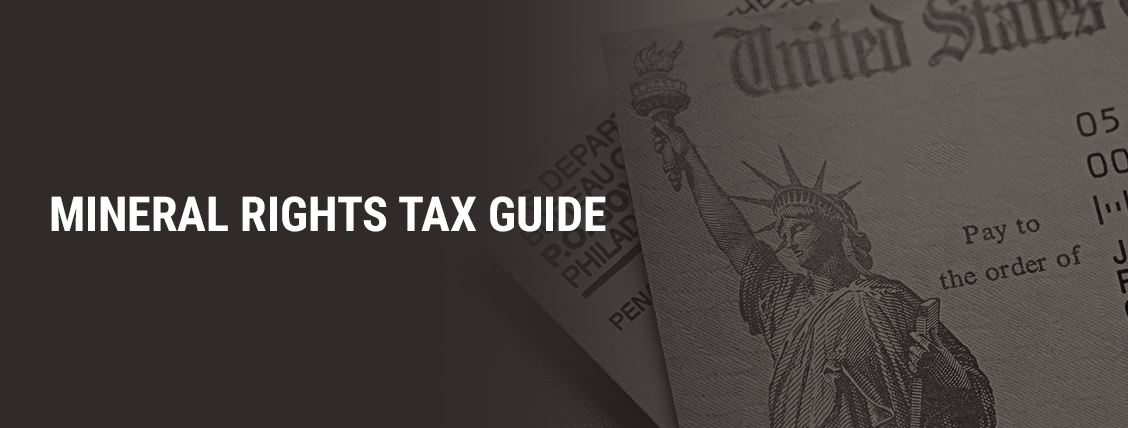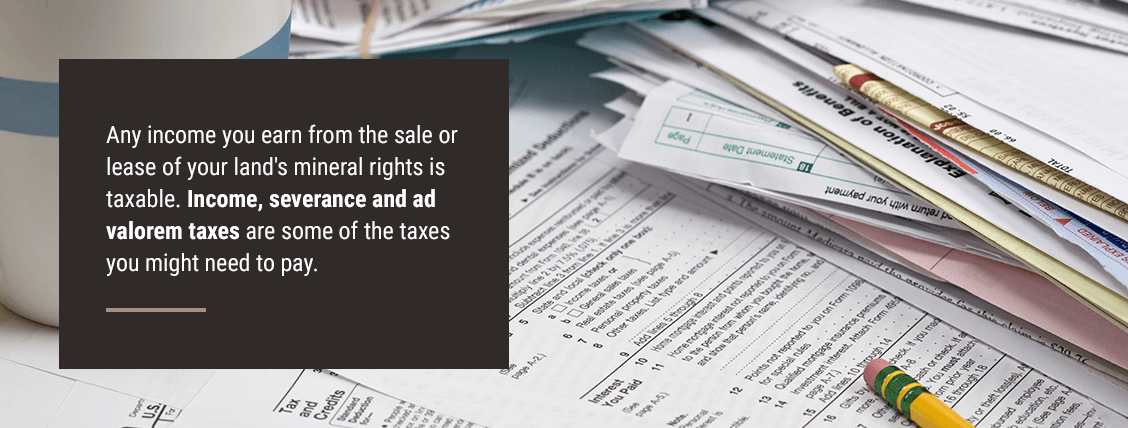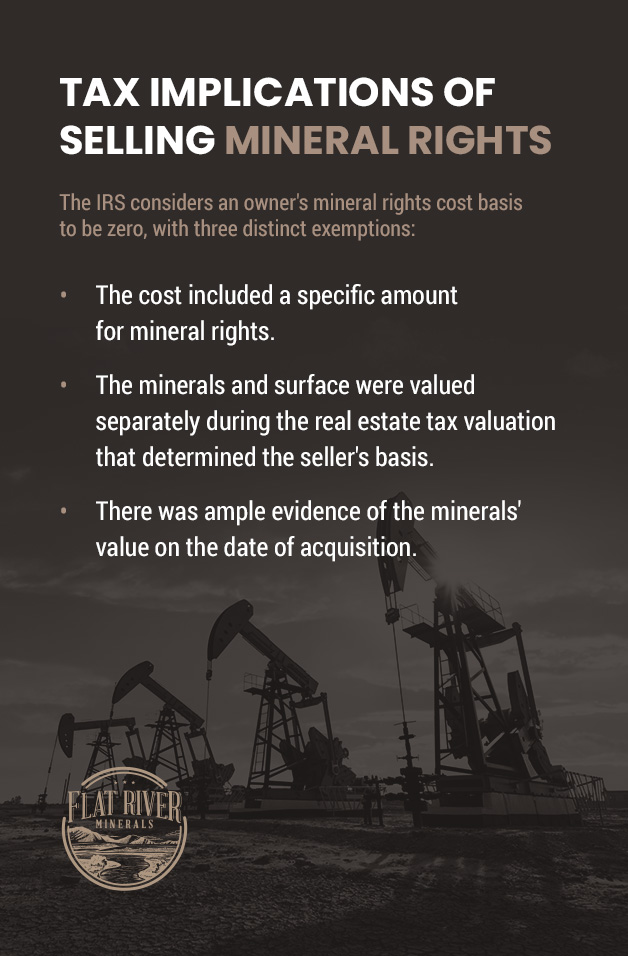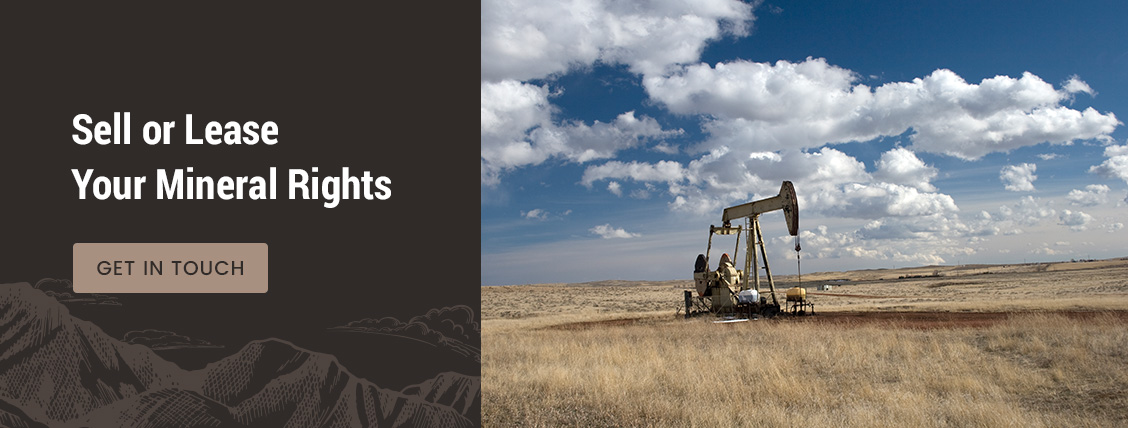Whenever you earn income, the tax agency typically wants to receive its cut. That’s also true when you sell the mineral rights to your land or lease the rights and receive royalty payments. The taxes you might owe on your land’s minerals depends on where in the U.S. your land is and what you decide to do with your mineral rights.
The income you earn might be taxed like regular income or considered a capital gain. Learn more about how the sale of mineral rights is taxed and what options are available to reduce your tax obligations.
Are you considering selling your minerals or mineral royalties? Contact us today for a free valuation.
Are Mineral Rights and Royalties Taxable?
Any income you earn from the sale or lease of your land’s mineral rights is taxable. Income, severance and ad valorem taxes are some of the taxes you might need to pay. Each type comes from a different entity. For example, income taxes are usually paid to the state or federal government and, in some cases, both. Ad valorem taxes are usually paid to the county and severance taxes to the state.
Ad Valorem Tax
Ad valorem is Latin for “according to the value.” The amount of the tax is based on the assessed value of a property or item. A common example of an ad valorem tax is a real estate property tax. When you own a home or land, the real estate’s assessed value determines the amount of taxes you pay. The tax due on land worth $100,000 will be less than the tax due on land worth $200,000 if the real estate is taxed at the same rate.
In Wyoming, ad valorem tax is a county-level tax. Each county in the state has its own rate, which can vary slightly from year to year. As of 2018, the average ad valorem tax statewide was 6.9%. To charge an ad valorem tax on oil and gas or minerals, the county needs to assess the minerals’, oil’s or gas’s fair market value on the property. Usually, the tax is only due when there is active production on a property.
State and Federal Tax
The income you earn from mineral royalties or the sale of mineral rights is often subject to federal and state taxes. The type of tax you need to pay depends on the type of income you earn.
Is the sale of mineral rights a capital gain? If you sell the mineral rights, you might have to pay a capital gains tax on the sale profit. If you purchased the minerals, the profit is based on the difference between the value or price you paid for the mineral rights when you made the purchase and the amount you sold the rights for. If you inherited the minerals, the profit is based on the difference between the value of the mineral rights when you inherited them and the amount you sold the rights for.
The tax rate depends on what your income bracket is and how long you had the asset. If you owned the mineral rights for less than one year before deciding to sell them, the tax rate would be the same as your income tax.
If you owned the asset for more than one year, you qualify for the long-term capital gains tax rate. The rate for long-term capital gains is based on your income level. If you earn less than $80,000, your capital gains rate is 0%. The rate is 15% for single people earning between $80,000 and $441,450. Those who earn more than $441,451 each year pay a rate of 20%.
According to the Internal Revenue Service (IRS), income taxes on mineral rights royalties work a bit differently. Capital gains taxes apply to the sale of mineral rights. If you retain your rights and lease them, therefore earning a royalty on the production, the royalty amount is taxed as regular income. Income tax rates tend to be higher than capital gain tax rates.
Depending on the state you live in, you might need to pay income tax on your mineral royalty earnings, too. Income tax rates vary wildly from state to state, with some states charging a progressive tax, similar to the federal tax structure. Some charge a flat rate. Others, such as Wyoming, have no income tax at all. North Dakota has a progressive tax that ranges from 1.1% to 2.9% of income.
Severance Tax
What is a severance tax for oil and gas? Thirty-four states collect a severance tax on oil and gas extraction, among them North Dakota and Wyoming. Because North Dakota and Wyoming are mineral-rich states, the severance tax often proves to be a significant revenue source for each state. In 2017, 22% of North Dakota‘s revenue and 8% of Wyoming’s came from severance taxes.
Severance tax rates vary based on the state and the extracted material. In Wyoming, the severance tax rate for minerals such as limestone, jade or clay is 2%, while natural gas or oil is 6%. In North Dakota, the severance tax is imposed in place of a property tax on land that produces oil or gas. The gross production tax for oil is 5%, while the gross production tax for gas is adjusted each year.
Taxes on the Sale of Mineral Rights
You might decide to sell your mineral rights for various reasons, such as the need for an immediate influx of cash or a desire to diversify your investment portfolio. It’s important to understand that if you sell your mineral rights, the tax situation will be different than if you kept the rights and leased them or earned a royalty from them.
Tax Implications of Selling Mineral Rights
Selling your mineral rights creates a different tax situation than earning a royalty. The IRS views the profits from the sale of mineral rights as a capital gain, not income. To figure out how much you might need to pay as a capital gains tax, you need to figure out your cost basis in the mineral rights. The cost basis is the original price or value of the asset — in this case, mineral rights.
Figuring out the cost basis can be complicated, depending on how you acquired the rights in the first place. Generally speaking, the IRS considers an owner’s mineral rights cost basis to be zero, with three distinct exemptions:
- The cost included a specific amount for mineral rights.
- The minerals and surface were valued separately during the real estate tax valuation that determined the seller’s basis.
- There was ample evidence of the minerals’ value on the date of acquisition.
Cost basis can also differ depending on whether you purchased the property or inherited mineral rights. Inheriting property often includes a step-up in basis, leading to a reduction in capital gains tax. Many owners do not know what the value of their minerals was at the time of inheritance, so don’t worry if you fall into this category. Professional mineral appraisers like Flat River Minerals can easily calculate historic values for you.
Quick tip: if you inherited your interest via a probated estate, look through the probate documents for an estimated value.
A few examples can help you see how to calculate capital gains and figure out what you might owe in taxes. Let’s say your income qualifies you for the 15% capital gains tax rate. You purchased the land and have a basis of $0 in it. Five years later, you decide to sell the mineral rights for $250,000. Since your basis is $0, your capital gain is $250,000. You would owe a capital gains tax of $37,500.
In another example, let’s say you inherited mineral rights and have a cost basis of $75,000. Five years later, you sell the mineral rights for the same amount, $250,000. To figure out your capital gains, you need to subtract your basis ($75,000) from the sale price ($250,000). Your capital gains are $175,000. Taxed at a 15% rate, you’d owe $26,250.
How to Report Sale of Mineral Rights on Tax Return
If you have capital gains from the sale of mineral rights, you’ll need to report them on your federal income tax return for the year you made the sale. The purchaser of the mineral rights might send you a tax form, such as a Form 1099, but they might not. Keep records of your basis and the sale price to report your capital gains at tax time accurately.
To report the sale, you’ll need to complete two additional forms when you file Form 1040. The first is Form 8949, which you use to tally up all of your transactions that resulted in capital gains or losses during the year. You’ll need to complete Schedule D to report your total capital gains. In this case, the tax treatment of selling mineral rights is similar to other capital gains.
Figuring out how to complete the tax forms and accurately report your earnings from the mineral rights sale can be complicated. It’s a good idea to work with a tax professional to ensure you are reporting the correct amounts and avoid paying more taxes than you owe.
Taxes on Mineral Royalties
Instead of selling your mineral rights, you’ve decided to lease them and are receiving royalty payments. Mineral and oil royalties tax treatment is different from taxes on the sale of mineral rights. Royalties typically get taxed like your regular income.
Oil and Gas Royalties Tax Treatment
If you lease your land to an oil or gas company and they begin drilling, you’ll start getting royalty checks. The checks’ amount depends on the income produced by the minerals or oils and the lease terms. For example, you might earn royalties of 25% of the production income.
You might earn more royalties at the start of drilling when there’s a high volume of oil or gas produced, and considerably less as the process continues and the supply diminishes. How much you earn in royalties and how much your total income determines the tax rate you pay.
For example, let’s say you earn a steady $5,000 per month in oil royalties over one year. The royalties are your only source of income for the year, totaling $60,000. The IRS treats the royalty income like any other income from employment or a business. You’d be responsible for paying tax on it based on your tax bracket. If you are single and only claim the standard tax deduction, your tax rate would be 22%.
Keep in mind that the royalty payments might be just a portion of the income you receive for letting a company drill on your land. If you get lease payments from the business or have gotten a lease bonus, you need to report that income as well. Rental income gets taxed at the same rate as your other income.
How to Report Oil and Gas Royalties on Tax Return
You should report royalty and rent payments on your federal income tax return. You’ll need to complete Schedule E to report rent or royalty payments or both. Schedule E also enables you to deduct expenses from your rent and royalty income. Your expenses might include attorney fees, surveying costs and the costs of creating contracts. It’s a good idea to work with a tax professional to make sure you claim the expenses you’re eligible for and avoid paying more taxes than required.
If you purchased the land intending to lease it out to mineral companies, you might be able to claim depletion, which is the cost of your initial investment divided by the potential value of the land’s minerals. You’ll report depletion on Schedule E, too.
It’s worth noting that you might need to make estimated tax payments each quarter depending on your income and tax obligation. Usually, you need to pay estimated tax payments if you expect to owe more than $1,000 when you file your return. Another option is to increase your withholding so you don’t owe additional taxes when you file your return if you have an employer that withholds tax from your paycheck.
1031 Mineral Rights Exchange
If you expect to owe capital gains taxes on the sale of your mineral rights, you could defer those taxes thanks to section 1031 of the Internal Revenue Code (IRC). You can defer taxes by exchanging your property for a “like-kind” property.
If you sell your mineral rights and use the proceeds to purchase something similar within 45 days — and what qualifies as “similar” will likely be broader than you expect — you can defer the payment of capital gains taxes on the proceeds of the first sale, since you used the money to buy something similar. Another way to look at a 1031 exchange is as a property swap.
To report the exchange and qualify for the tax deferment, you need to file Form 8224 with your tax return for the year. It’s essential to dot all your I’s and cross all your T’s when doing a 1031 exchange, so it’s a smart idea to find a tax pro to help you out.
Sell or Lease Your Mineral Rights
If you’re interested in selling the mineral rights to your land or leasing a royalty interest , work with an oil mineral buyer that lives by the Code of the West and focuses on doing the right thing — which isn’t the same as the easy thing. Flat River Minerals is a local company committed to keeping your minerals in Wyoming.
We practice a buy-and-hold method, meaning we won’t flip or sell your minerals to the next highest bidder. To learn more about our process and what makes us different, get in touch today for a free valuation.





